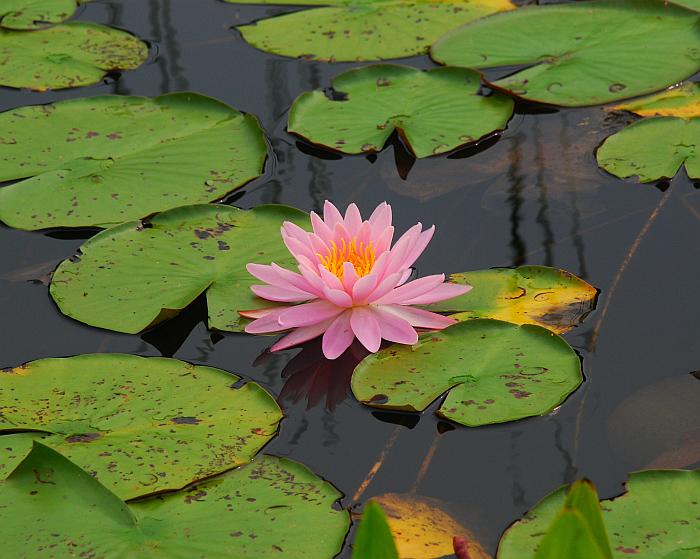Nymphaea odorata Aiton
Fragrant Water Lily

Native
CC = 7
CW = -5
MOC = 20
© SRTurner
Nymphaea odorata AitonFragrant Water Lily | |
 |
Native CC = 7 CW = -5 MOC = 20 |
© SRTurner |
|
Family - Nymphaeaceae Habit - Floating-leaved aquatic, sometimes emergent or submerged, particularly in dense populations, rarely stranded on mud. Stems - Rhizomes relatively stout, not flattened, white to off-white (this often obscured by blackish hairs), sometimes producing tubers, these actually simple or compound branches to 8 cm that are strongly constricted at the base and easily dispersed. Leaves - Submerged, floating or occasionally emergent; the submerged leaves similar to the floating ones but usually somewhat more membranous; the floating and emergent leaves leathery and mostly long-petiolate. Leaf blades 6-20 cm long and wide, circular or nearly so, rounded at the tip, attached in the sinus of a narrowly V-shaped, deeply cordate base, the lobes asymmetrically angled at the tip or sometimes with a small, slender, tapered extension at the very tip, both surfaces glabrous, the upper surface bright green to dark green, usually somewhat shiny, the undersurface often strongly tinged with red to purplish brown, the venation palmate but also pinnate along the midvein.
Inflorescence - Flowers floating or less commonly slightly emergent, deeply perigynous, the stalk usually relatively slender, becoming coiled and submerged as the fruits mature, glabrous. Flowers - Mostly 6-19 cm in diameter when open. Sepals 4, 2.5-8.0 cm long, ovate or narrowly ovate, rounded at the tip, flat to shallowly concave, spreading to reflexed and not cupped around the pistil at flowering, often reddish-to purplish-tinged on the outer surface, the margins thin and usually relatively pale, not persistent. Petals numerous, showy, spreading to reflexed, 3-9 cm long, slightly shorter to slightly longer than the sepals, ovate to narrowly elliptic or elliptic-lanceolate, flat to slightly concave, rounded to narrowly rounded at the tip, grading into the stamens (the innermost staminodial petals narrowly oblanceolate), white or rarely pink, not persistent. Stamens 10-40 mm long, rounded to bluntly pointed at the tip. Ovary nearly inferior, the perianth and stamens attached to a hypanthium that extends nearly to the ovary tip and is fused to the ovary sides. Stigmatic disc 5-22 mm in diameter, with 10-25 slender lobes, these stigmatic toward the tip.
Fruits - Berrylike, 2.5-4.5 cm long, depressed-globose, shallowly and broadly concave at the tip, not ribbed, but the lateral walls with transverse scars from the shed perianth parts and stamens, green, indehiscent. Seeds ovoid, 1.5-4.5 mm long, the surface smooth, olive green to orangish brown, covered by a membranous, bag-shaped, white aril. Flowering - May - September. Habitat - Ponds, lakes, sloughs, and slow-moving to stagnant portions of rivers, ditches. Also cultivated. Origin - Native to the U.S. Other info. - This striking species is found in scattered counties throughout Missouri. Though not particularly common, it can be quite abundant where it occurs. Its native range encompasses the eastern half of the U.S., though it is by far most common in coastal regions. The plant is easily recognized by its floating aquatic habit and round leaves with a narrow, wedge-shaped notch reaching to the center of the leaf. Photographs taken in Marquette, MI., 9-5-03 (DETenaglia); also at Shaw Nature Reserve, Franklin County, MO, 5-7-2007, 5-13-2010, 6-26-2013, and 7-22-2020, and Brownsmead, Lincoln County, MO, 7-11-2009 (SRTurner). |